Perhaps one of the most underappreciated players of his generation, Busquets has revolutionized the role of defensive midfielder by combining defensive prowess with technical excellence.
From playing alongside greats of the game, such as Andrés Iniesta and Xavi, in Barcelona’s golden era in the modern game to being part of the rebuild of the current side that has recently claimed La Liga glory, Busquets has given his career to Barca and has etched his name into the club’s history books.After surpassing 700 appearances in a multitude of competitions that include countless UEFA Champions League fixtures, it has recently been confirmed that the Spaniard will be departing the Catalan club in the summer, currently 34 years of age.
Filling the boots of such a highly decorated individual is a difficult yet vital task as it will help shape the future of Barcelona for years to come; just as Busquets did back in 2008.
This data analysis will use xGold, TFA’s unique player similarity tool, to identify potential targets for manager Xavi.
The data will highlight players from a variety of leagues around the world, with xGold selecting them not only on ability but also on their similarity to Busquets’ play style—an important factor as this will give us a stronger indication of a player’s ability to fit into Barca’s tactics.
Before we dive into the statistics, let’s address the elephant in the room.
Barca’s financial issues are no secret, and it was recently reported that La Liga had placed a transfer ban on the champions for the summer window. Further reports claim that they have to raise £178m through player sales before being able to bring anybody into the club.
Now, Barcelona have several individuals they could offload, with interest from other clubs already starting to build, but even if they fail to overcome this transfer ban, it is possible that they replace Busquets with a player already on their books and then go in to purchase a new midfielder in 2024.
Criteria
For this data analysis, we have decided to cast a wide net to bring up an array of names – some that may be obvious in terms of being linked to Barca and some that will not yet have been considered.
With that in mind, the players included in this data analysis meet the following criteria:
- Play in the top division of Spain, England, Italy, France, Germany, Portugal, Holland, Argentina, or Brazil
- Be aged between 18 and 28 at the time of writing
- Be listed as a defensive midfielder by Wyscout/xGold
In addition to external options, we have also included current Barcelona players Frenkie de Jong, Sergi Roberto, and Franck Kessié, as they all fit the defensive midfielder bill.
Of course, Busquets’s data from this season has also been included, acting as a benchmark.
xGold highlights players who meet the above criteria, ranking them in order of similarity to Sergio Busquets. Every player involved has a similarity rating of at least 80% to the Spaniard.
Sergio Busquets Defensive ability
It goes without saying that defensive ability is the bedrock of a defensive midfielder—being able to read and break up opposition possession and get stuck in with a variety of duels are ways of contributing to your team’s defensive efforts.
Here, we look at the contributions of the players involved.

We kick things off by looking at how each player tends to perform defensively as a whole, giving us an idea of who is consistent and well-rounded in this regard.
Busquets comes in with 10.81 successful defensive actions per 90, so that’s the one to beat.
Jumping out straight away is Mats Wieffer of Feyenoord. The 23-year-old has impressed many this season in the Eredivisie, and his defensive contributions have played a huge part in that.
The Dutchman has averaged 13.76 successful defensive actions per 90 this season in the league, more than any other player on this list.
Looking elsewhere, we see promising entries from Stuttgart’s Atakan Karazor (11.95), Leeds United’s Tyler Adams (11.68), and Benfica’s Florentino Luis (11.6) – all of which are higher than Busquets’ entry, so we’re off to a flyer!

Moving on to look at total duels.
This included defensive duels, of course, but also things like aerial duels and offensive duels.
This metric lets us see just how aggressive each player is as well as how well they use that aggression to win their duels.
Busquets averages 18.57 duels per 90
—amongst the highest involvements—and has an impressive win rate of 58.05%—onlyTyler Adams and Martín Zubimendi boast higher win rates on this list.
Wieffer is back again thanks to his unmatched average per 90 of 27.56, with a win rate of 55.54%, which is incredibly impressive his average attempts – very few on this list average more than 20 per 90, and even very few of those have bettered his win rate.

Next, we zoom in on one of the most critical areas for a defensive midfielder: defensive duels.
Busquets averages 7.88 defensive duels per 90 and comes away winning 65.9% of them – numbers that put him in the ‘above average’ category.
And once again, Mats Wieffer stands out thanks to his whopping average of 10.23 defensive duels per 90 – the only player here to surpass 10 attempts.
His win rate
is around the mid-mark this time (60.08%), which should still be considered good consideringhow often he engages in defensive duels.
The highest win rate is held by Bologna’s Dutch midfielder Jerdy Schouten, who wins 74.88% of his 6.73 duels per 90, while Tyler Adams and Ezequiel Fernández (Boca Juniors) also deserve a tip of the hat for their decent balance of engagement and effectiveness.

Being able to cut out opposition passes is an important element of a defensive midfielder’s arsenal – not only can it halt an opponent’s attacking move, but an interception can also be the catalyst for a turnover and even an attacking transition.
For this data analysis, the interception metric has been possession-adjusted, giving us a better idea of who makes the most interceptions on an even playing field.
Busquets does well in this field, averaging 5.16 interceptions per 90.
Wieffer (again) deserves credit
for his excellent average of 10 interceptions per 90 minutes, which highlights his ability to read the game and disruptopposition play.
Schouten (8.84), Salih Özcan of Dortmund (8.7), and Thiago Maia of Flamengo (8.92) all make good ground in terms of interceptions as well and deserve recognition for that.
Defensive midfielders don’t just defend…
Modern football requires every position on the pitch to have some level of technical ability, especially at the top, and especially for a team with tactics like Barcelona.
Being able to win possession back alone isn’t enough to qualify you for a place in such an elite squad – there has to be a high level of technical ability, too.
Sergio Busquets doesn’t really get his flowers when it comes to this, but if you’ve watched the midfield maestro play, you’ll be well aware that he is a natural in possession.
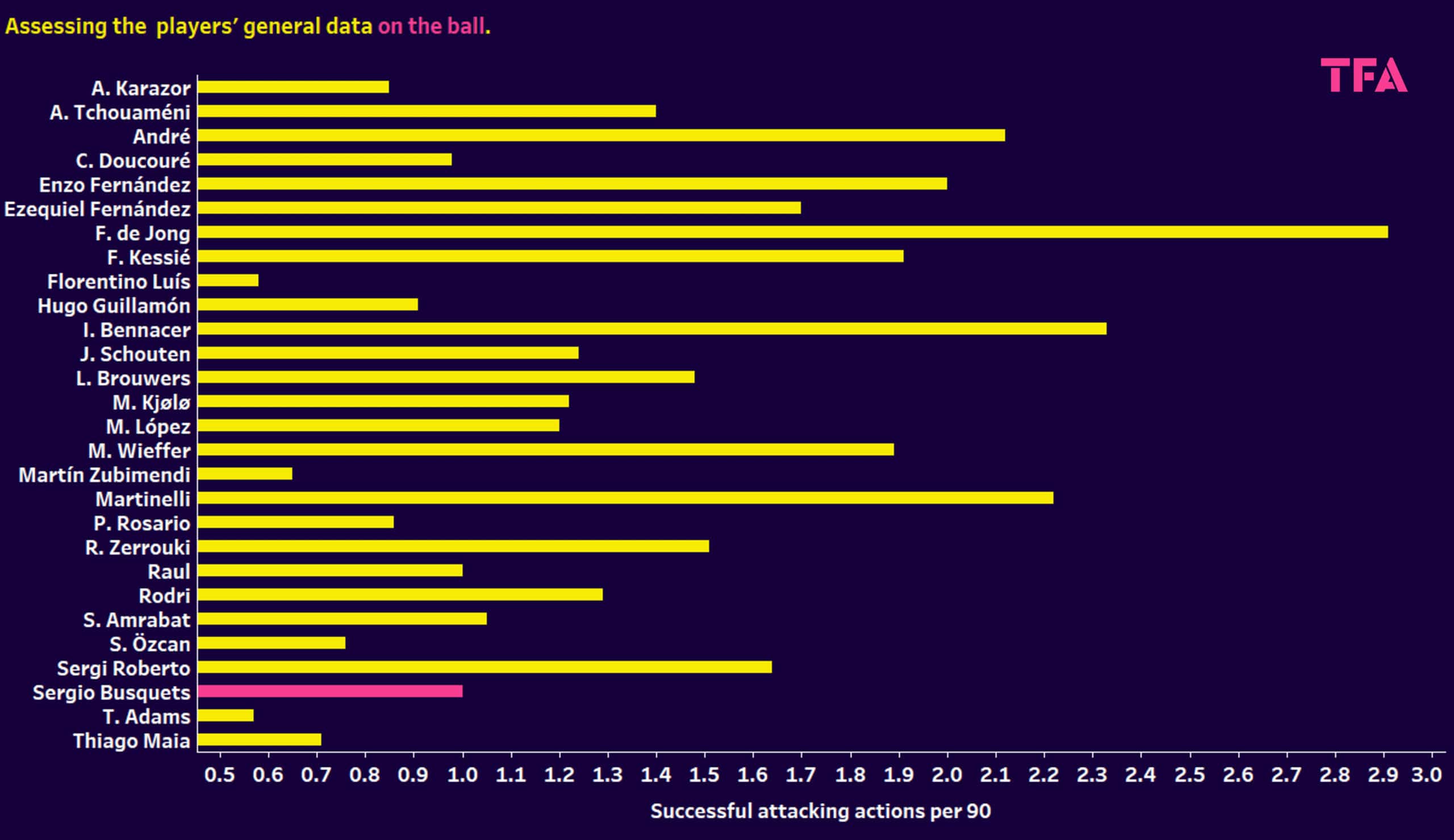
Starting off in a similar fashion to the defensive portion of this analysis, let’s examine each player’s statistics regarding overall attacking actions.
This is where the tactics of the players’ respective teams come into play, as Busquets ranks among the lowest on the list, averaging one successful attacking action per 90 minutes.
A whole cluster of players surpass Busquets’ average, but a few stand out.
One of them is Busquets’ teammate, Frenkie de Jong, who has experience playing a deep midfield role.
De Jong averages 2.91 successful attacking actions per 90, more than anyone on the list.
AC Milan’s Ismaël Bennacer and Fluminense midfielders André and Martinelli also post positive numbers in attacking actions.
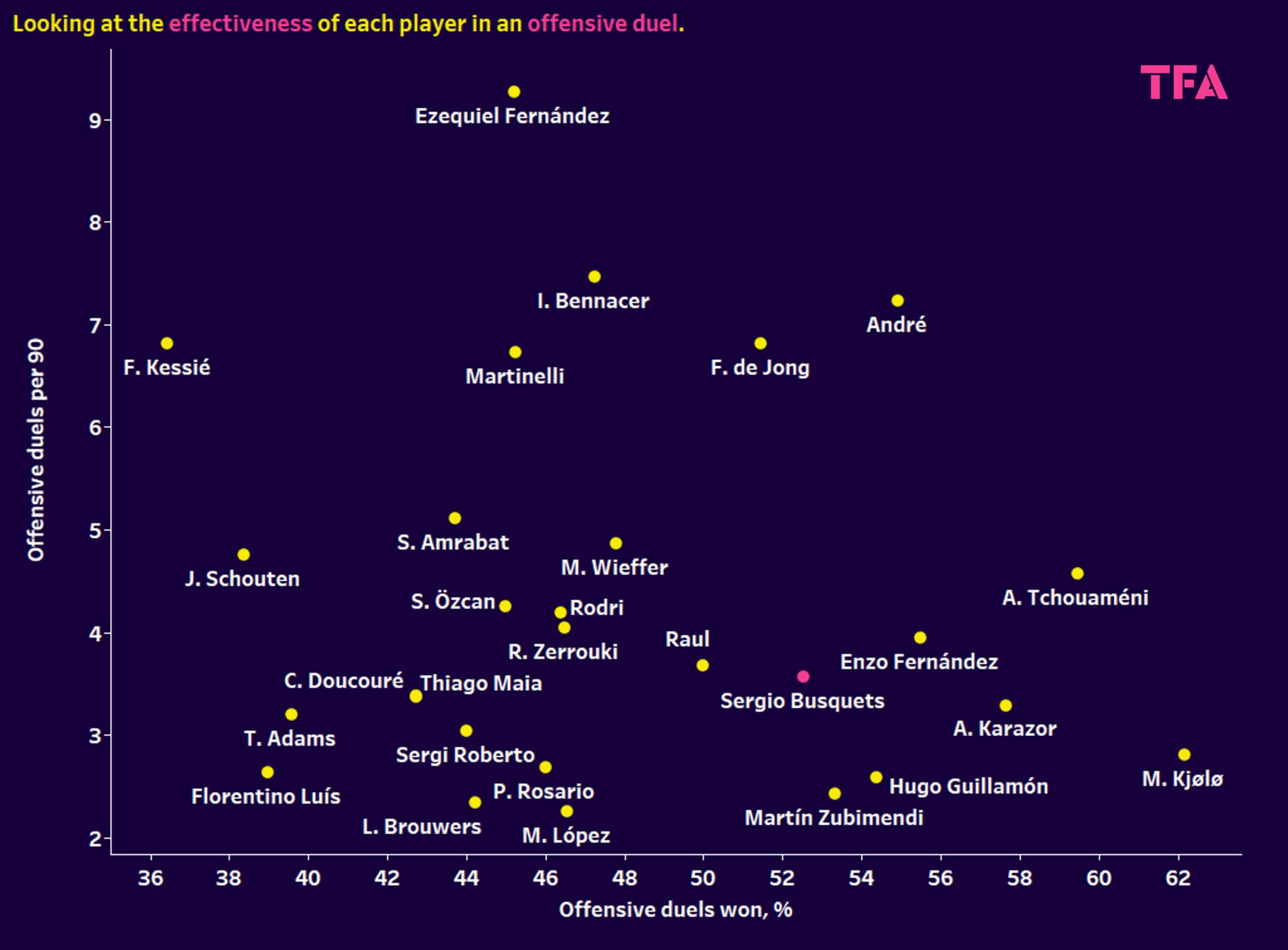
Being successful in offensive duels indicates an ability to defend the ball from opposition challenges, and thus, it is an important skill for a midfielder—being able to keep the ball under pressure rather than losing it in dangerous areas and giving the opponent the chance to counterattack.
Busquets has one of the lower averages for this metric (3.56) but posts a decent win rate of 52.52%, bettered by only a tiny few on this list.
The highest win ratio goes to another player with a low attempt average – Mathias Kjølø of Eredivisie side FC Twente, who wins 62.16% of his offensive duels.
Other players with high win rates are Real Madrid’s Aurélien Tchouaméni, Karazor, André, and Chelsea’s Enzo Fernández.
Boca Juniors midfielder Ezequiel Fernández boasts the highest attempt average (9.27), and his win rate of 45.21% is not bad at all considering his rate of engagement.
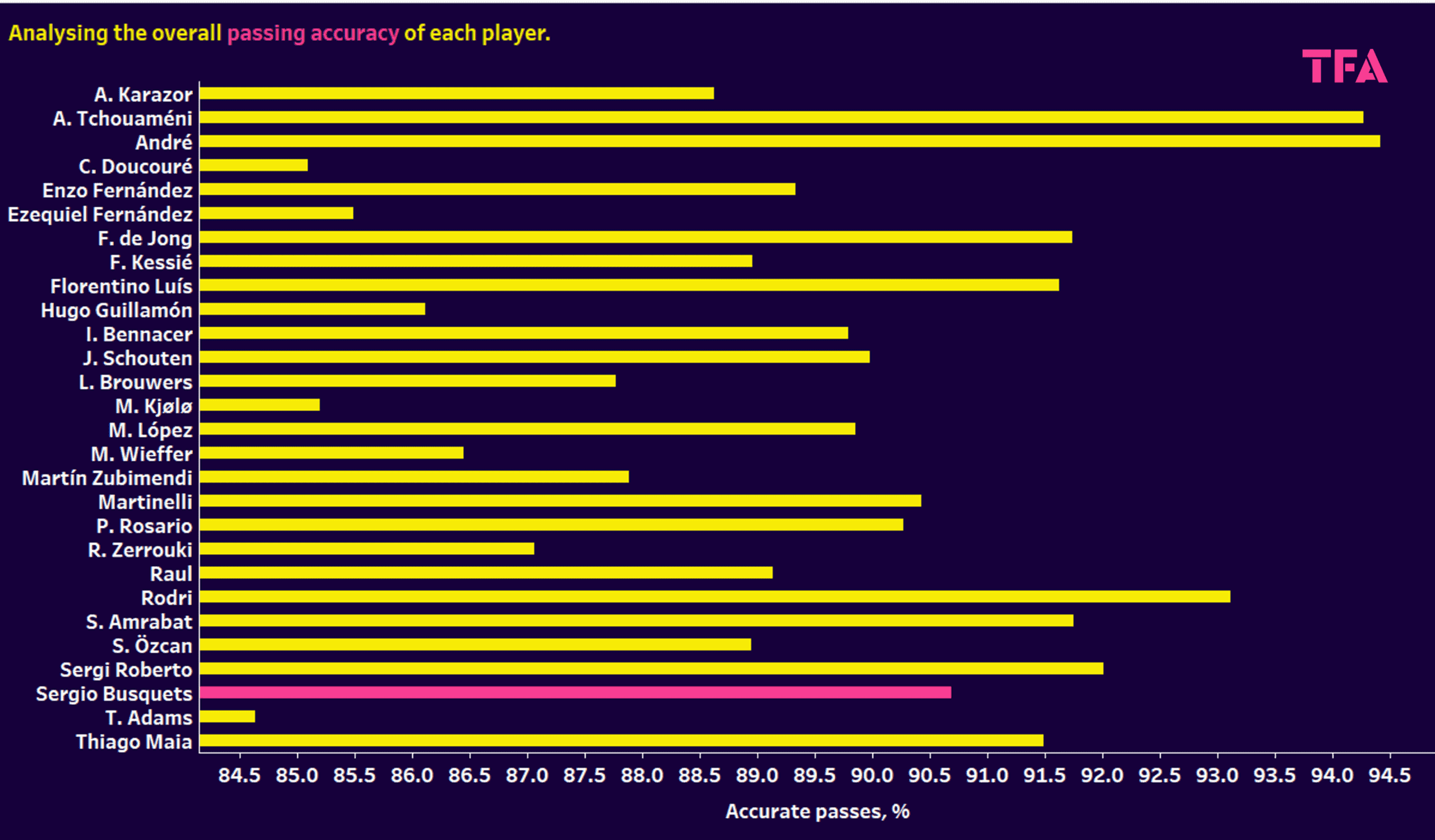
We now look to get a sense of the passing ability of each player as this is a vital attribute if you are to wear the Barcelona badge.
Judging the overall passing accuracy provides a foundation for us from an analytical perspective and also tells us who the consistent ones in the group are.
Busquets registers a strong accuracy rate of 90.69%, and while this is a good number, a few surpass it easily.
André takes the top spot with a mouth-watering accuracy rate of 94.42%, and he is closely followed by Tchouaméni with 94.27% – both incredibly consistent with their passing.
Manchester City’s Rodri, who, granted, is an improbable target for Barca, does nicely with passing accuracy, as does Florentino Luís (Benfica) and Barca’s own Frenkie de Jong.
Interestingly, another Barca player, Sergi Roberto, now 31 years old and seemingly a fringe player at the club, also surpasses Busquets’ passing accuracy.
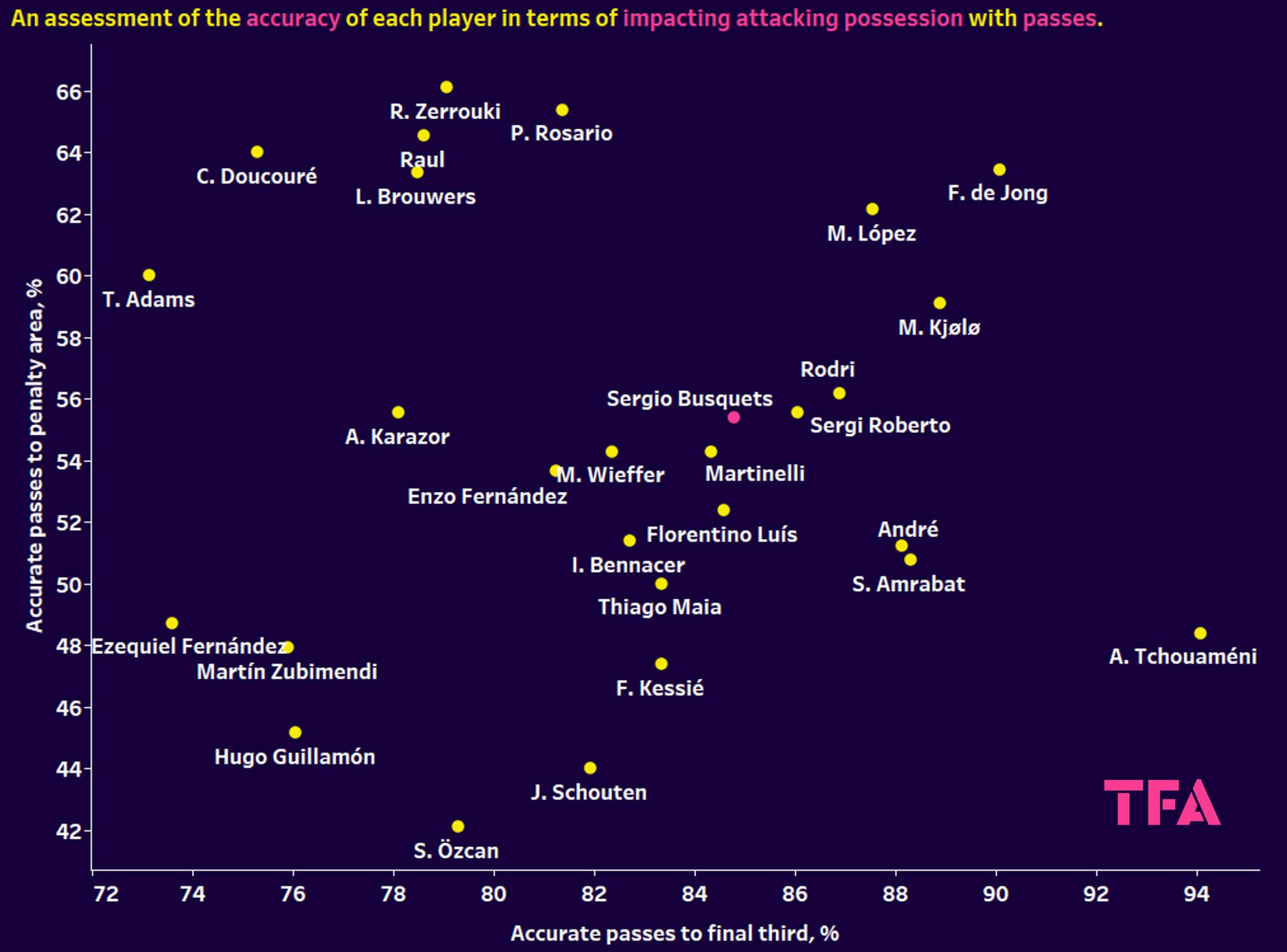
Jumping forward to get a better idea of how each player uses passing as a tool to aid their teams’ attacks, we now look at their statistics in terms of passing to the final third and the penalty area.
Looking at both of these stats will help build a stronger idea of who has the confidence, consistency, and ability to play those effective, often riskier passes.
Busquets comes in just above average for this one, indicating an ability to get involved in attacking build-up play.
Tchouaméni is the one with the highest accuracy rate for passes in the final third, yet he seemingly struggles to find the same edge when passing into the penalty area.
Perhaps the best choice in terms of scoring high on both metrics is de Jong.
The Dutchman has an accuracy rate of 90.07% when passing into the final third with a rate of 63.44% when passing into the penalty area.
We all know of de Jong’s excellence on the ball so this really should come as no surprise.
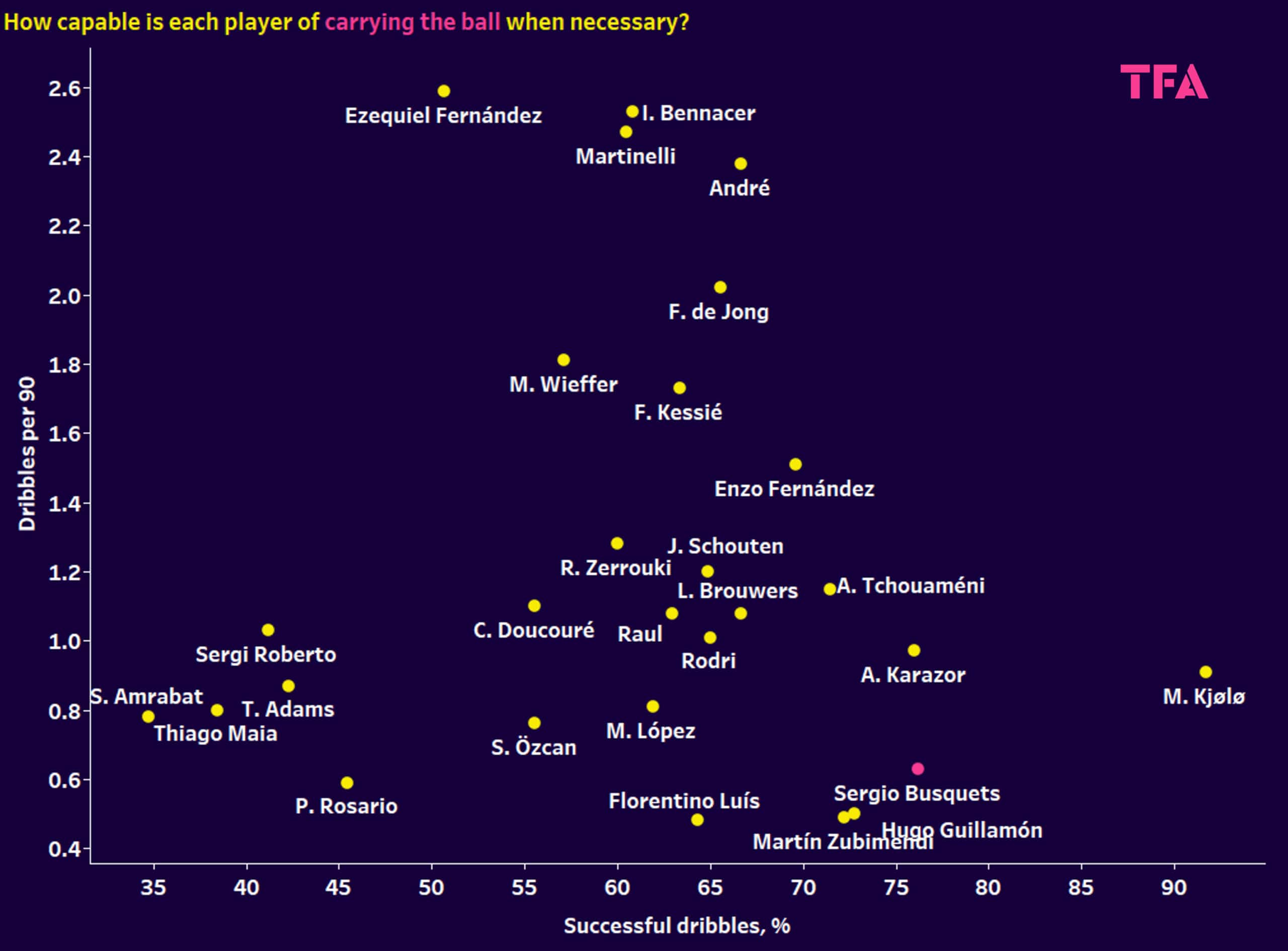
As the graph above tells you, Busquets’ role doesn’t require a great deal of dribbling.
The veteran is highly skilled, with brilliant close control and footwork, so his lack of pace doesn’t matter much.
Yet, along with his low dribbling average, he is effective when called upon, with a success rate of 76.19.
In fact, only Kjølø beats that number, and he has a slightly higher attempt average.
You can see that there are a few players who aren’t scared to attempt a higher number of dribbles but lack a strong success rate.
What is important with this metric is finding the balance.
Players like André and de Jong tick this box, and Karazor’s entry shows similarities to Busquets too.
Top recommendations
Can he pass? Can he dribble? Is he defensively sound? If the answer to all these is yes for any of the players involved in this data analysis, chances are they’re in with a shout of at least being linked to Xavi’s squad.
That isn’t to say that Barca won’t sign someone who, for example, is defensively sound but not as accomplished on the ball, as there is enough talent everywhere else on the pitch to do that job.
However, the chances of Barca bringing in a player who lacks the defensive steel to replace Busquets are astronomical, so players who fit that description are off the table.
Players like Rodri and Tchouaméni are unlikely to switch to Barca, so they are excluded from the suggestions list.
To wrap things up, we will suggest four potential replacements.
There are a number of strong candidates on this list with a bright future, but we have to narrow this down to who we think are the most suitable and realistic options for Barcelona.
Frenkie de Jong – Current Barcelona Squad Member:
Given Barca’s situation off the pitch, this may be their number one solution, but let’s not forget the interest from other clubs in de Jong.
He has experience in a defensive role from his time at Ajax and possesses the tactical awareness and quality on the ball to succeed as a defensive midfielder despite having a different profile from Busquets.
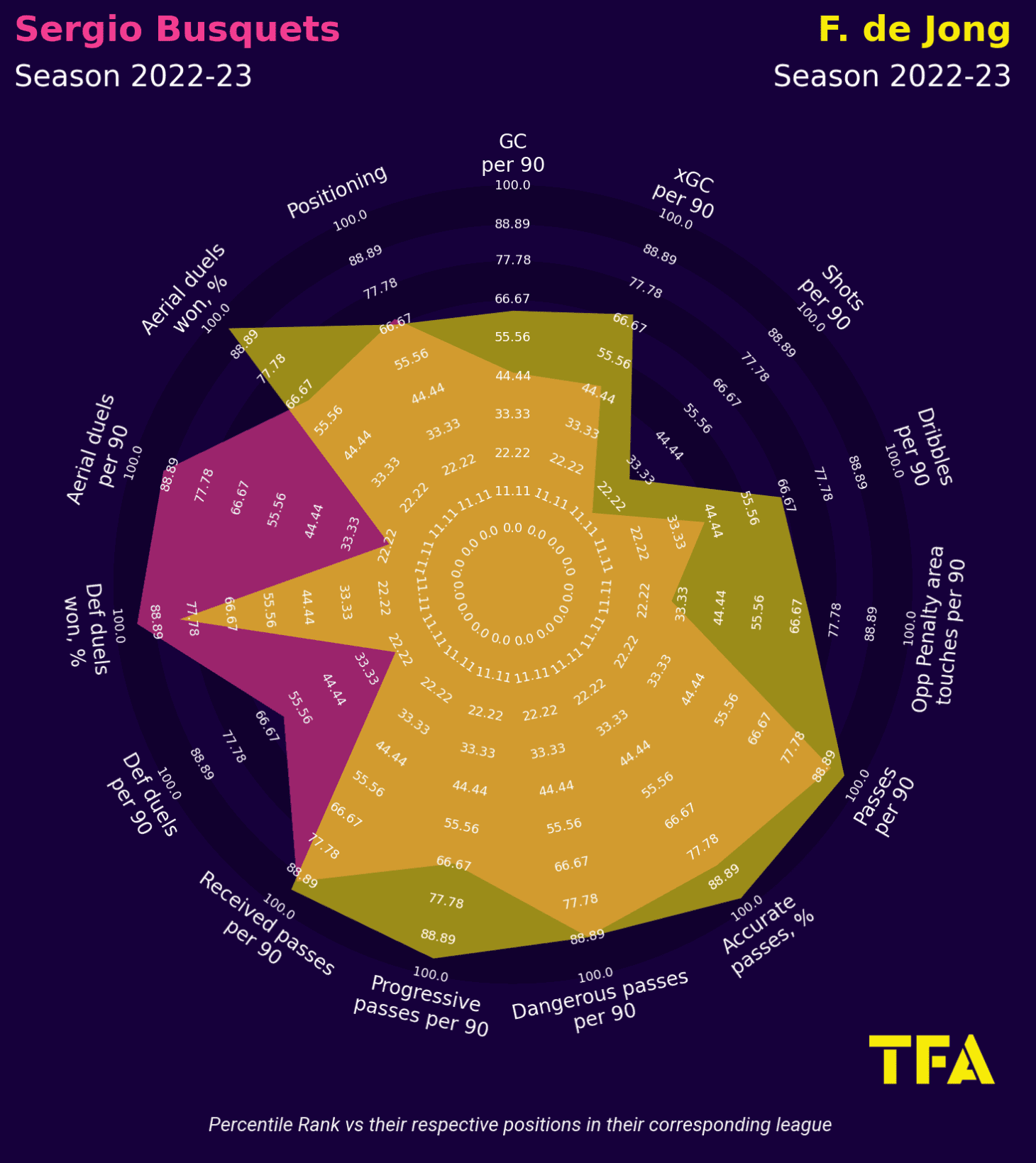
When comparing de Jong’s percentile entries to those of Busquets’, we can immediately see that de Jong offers less engagement in duels, with Busquets registering at a higher percentile on aerial and defensive duels.
However, in terms of success rates, the story is slightly different—de Jong still fails to match Busquets with winning defensive duels but still registers at a high percentile, offering signs of promise in the defensive department.
He also lands a higher percentile ranking with aerial duels by some distance, but it is essential to consider that Busquets ranks much higher in aerial duel attempts.
What de Jong does offer in bucket loads is creativity from midfield areas.
If it wasn’t clear before, it will be now! He surpasses Busquets in all in-possession metrics in the image above in terms of percentile ranking.
Not only does he better Busquets’ record on the ball, but his de Jong’s percentiles also rank him amongst the best in the league for central midfielders, highlighting his ability on the ball.
If de Jong was to drop into the defensive midfield role due to being vacated by Busquets, we should expect his percentile ranking to drop in certain areas, like touches in the opposition penalty area, for example.
André – Fluminense, Brazilian Serie A, similarity rating 84%:
At just 21 years of age, André is still far away from his peak years but already looks to be a talent.
With a market value of just £12.1m, he could be a top pick for Xavi and his men.
His name popped up across several metrics in this data analysis, suggesting he has real potential.
Barca are no stranger to signing prospects from Brazil, so this isn’t a far-fetched suggestion.
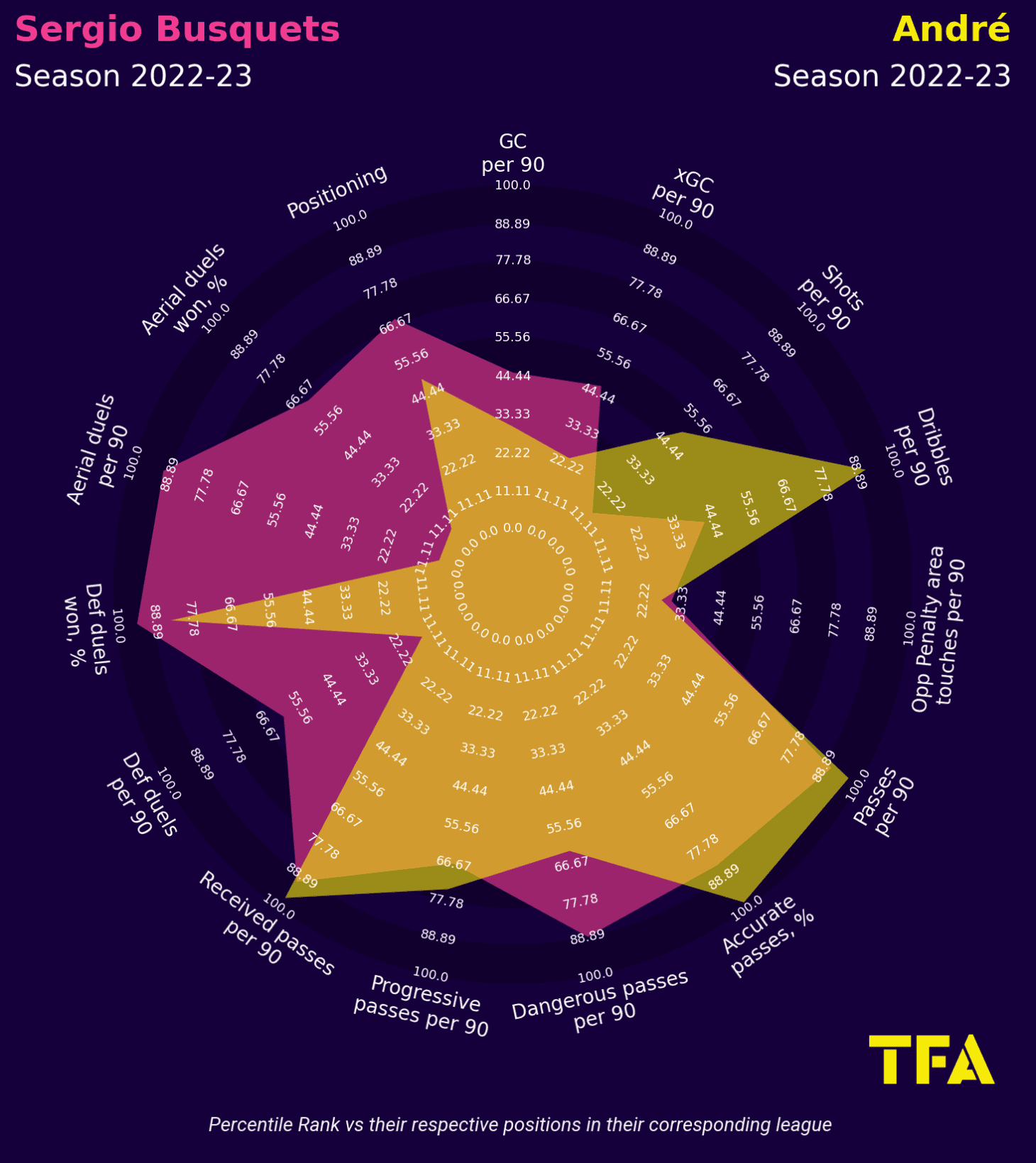
André’s percentile radar tells us that while he is far from the finished product in some areas, he is still competing and contributing to an effective level in Brazil.
As indicated by his high percentile ranking above, he often runs with the ball, which would offer a slightly different dimension to the defensive midfielder role in comparison to how Busquets has played it.
André ticks the boxes when it comes to passing in terms of frequency and accuracy while also posting good numbers for progressive passes.
André, like de Jong, offers fewer duel attempts, something that would need to be rectified if he wore Barca’s colours. However, he does offer a good win rate in defensive duels, posting a percentile that ranks him amongst the top in his position and league.
Mats Wieffer, Feyenoord, Eredivisie, similarity rating 83%:
At 23, Wieffer is already an important figure at Feyenoord, largely thanks to his amazing defensive ability.
While his statistics in attacking metrics didn’t highlight this, he is more than capable in possession.
His market value currently sits at £7m, so if Barca are looking to spend a reasonable amount of money, this guy might be one to look at.
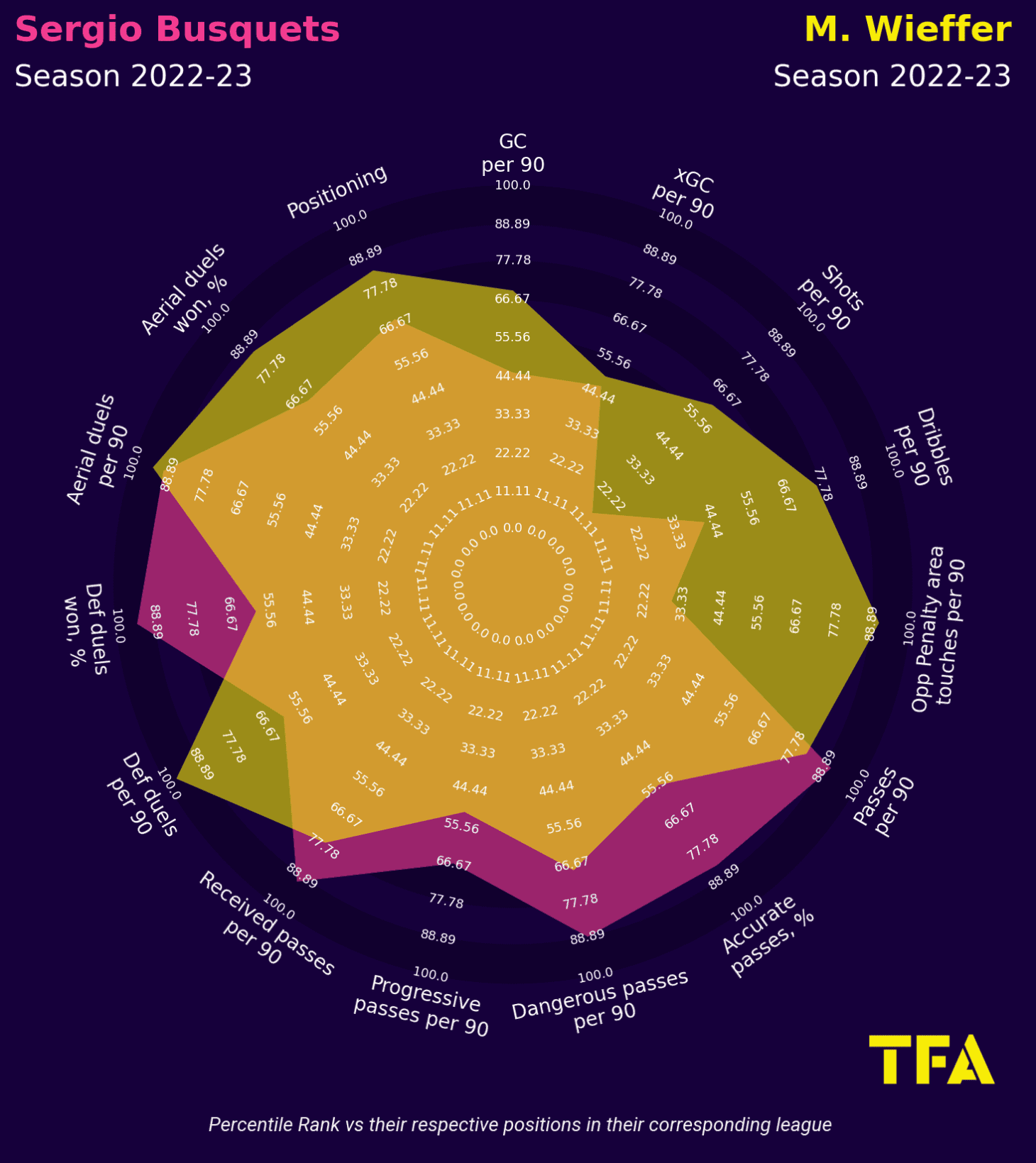
If Barca are looking for someone who offers high duel engagement, Mats Wieffer might be the man.
Of the four options we have highlighted, he is the only player to get near the attempts ranking for both aerial and defensive duels – in fact he surpasses Busquets’ percentile ranking, with Wieffer ranking in the highest percentile for central midfielders in Eredivisie.
He offers an aerial presence too, ranking high for aerial duels success rates – at 6″2′ he appears to be difficult to match in the air! One thing that may register as a slight concern for Xavi when assessing this player is the average percentile ranking for defensive duel win rates – this is something he would have to work on to bring his game to the next level.
On the ball, Wieffer is fairly active as well, offering high percentile ranks for shooting, dribbling, and touches within the opposition box – though these could all drop to a lower percentile if he plays a more defensive role that mirrors Busquets’ role.
Passing doesn’t seem to be his strongest area, at least when compared to other players in his position
and league, so this might be something that Xavi keeps in mind. His passing accuracy sits at 86.44% for the season, so his passing isn’t terrible;it just doesn’t stand up against a lot of other central midfielders in Eredivisie.
Martín Zubimendi – Real Sociedad, La Liga, similarity rating 85%:
The media seems to think that Zubimendi is Xavi’s number one selection to replace Busquets, and it’s no surprise why.
While he didn’t excel in many metrics, he does his talking on the pitch and has been highlighted as one of the best defensive midfielders in Spain for a couple of years now.
He may cost a little more than the other suggestions, though, with his market value sitting at £34.7m.
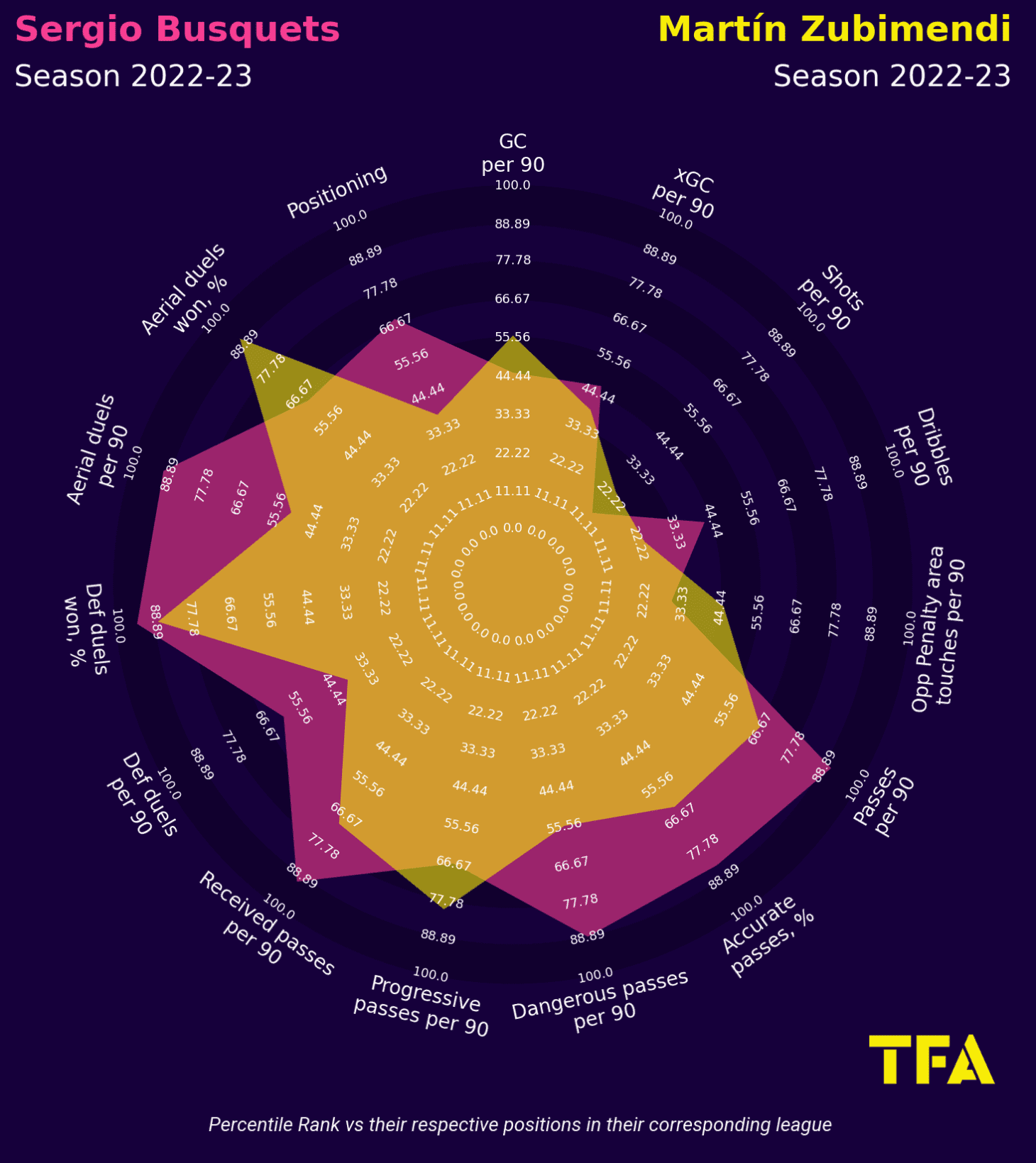
Perhaps the obvious choice for many, Zubimendi offers strong defensive qualities – while he ranks low for attempts in both defensive and aerial duels, he posts extremely promising percentiles in the win rates of both categories, so he can be relied on defensively.
He isn’t much of a dribbling fan judging by his low percentile ranking, but still gets involved in attacks via shots and touches inside the opposition box.
He seems to offer a good passing range
—despite his mid percentile rank for both passes per 90 and pass accuracy, he still offers an accuracy of 87.88%. He also posts a fairly promising percentile rank for progressive passes, bettering most of the players in his position and league, including Busquets.
Conclusion
While directly replacing a decorating player like Sergio Busquets will be an extremely difficult task, even without the pending transfer band, Barca could explore a whole host of players to build for the future.
We have identified three external options based on our data, along with Frenkie de Jong who is already a Barca player – whether Xavi sees him as a long-term defensive midfielder or not is another matter, but may be short-term option he is forced into if Barca can’t sign anybody new.
In a nutshell, they’ll be looking for someone who offers quality and consistency in defensive and passing areas mainly, but they will also want a character who can handle the pressure of playing on a big stage.

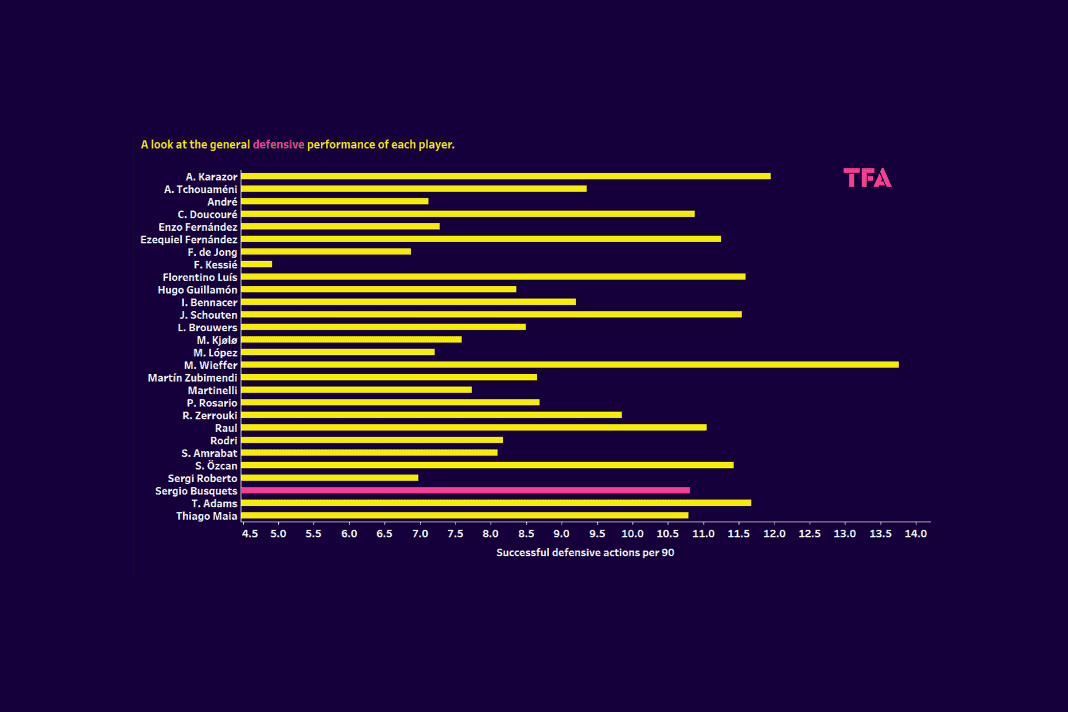




Comments